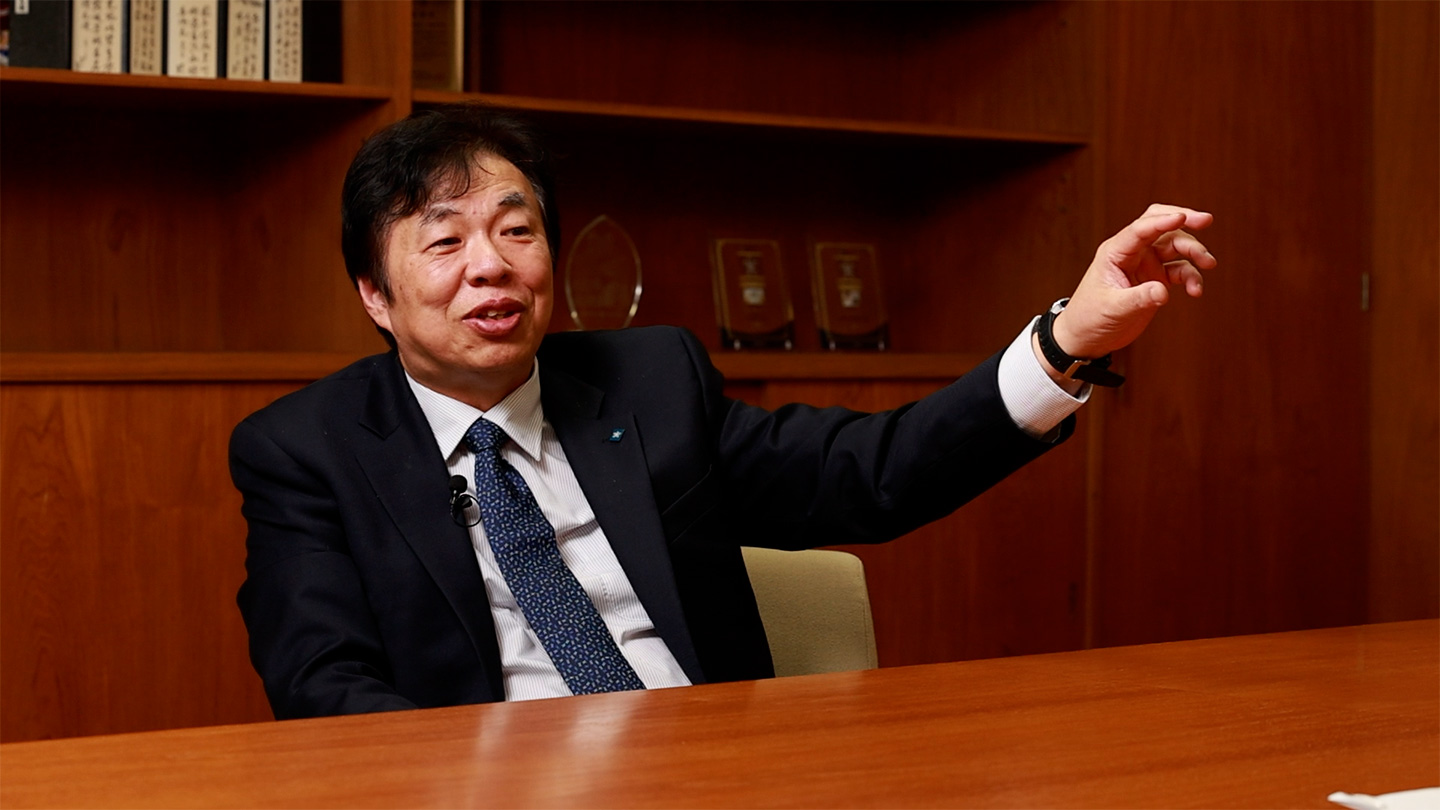Survey or Interview松村 到
得意分野で研究力を伸ばし
近畿大学のブランドをさらに高める
Pushing the boundaries of research— uplifting Kindai University’s global presence.
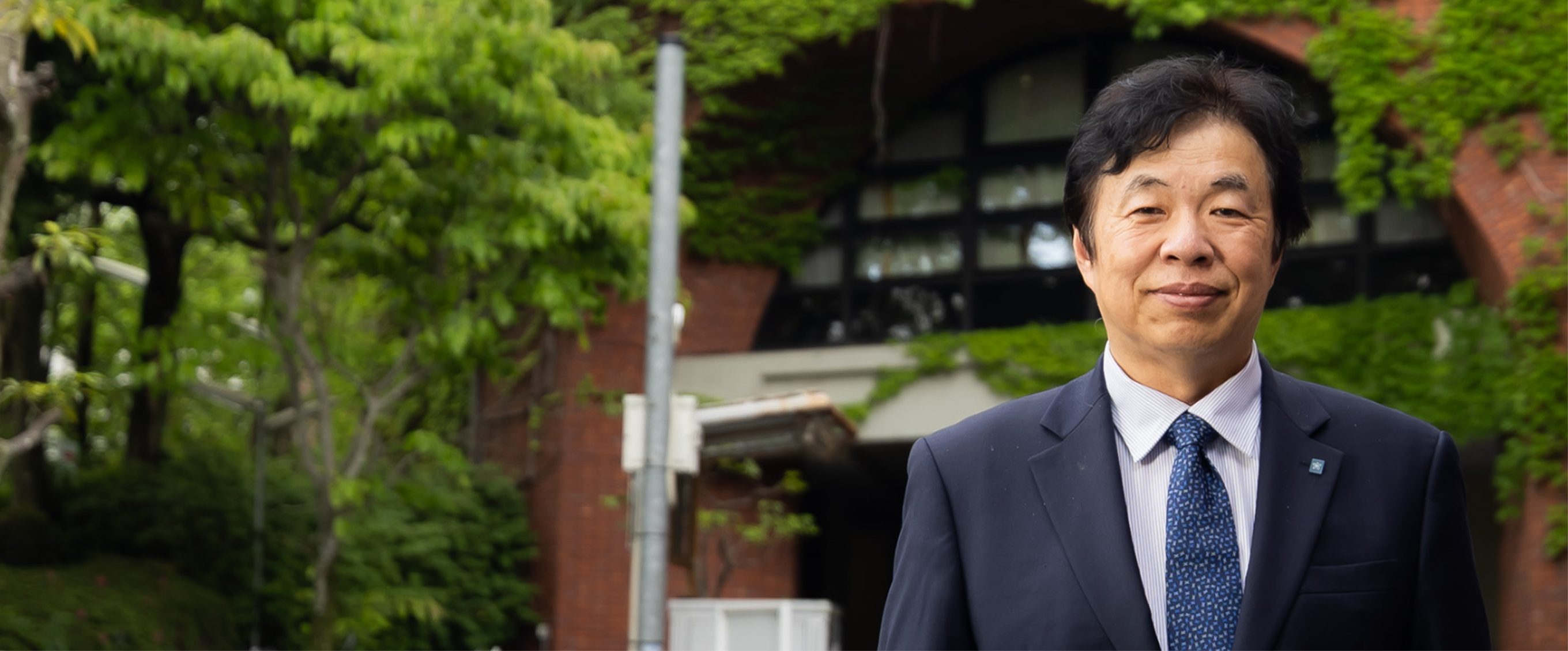
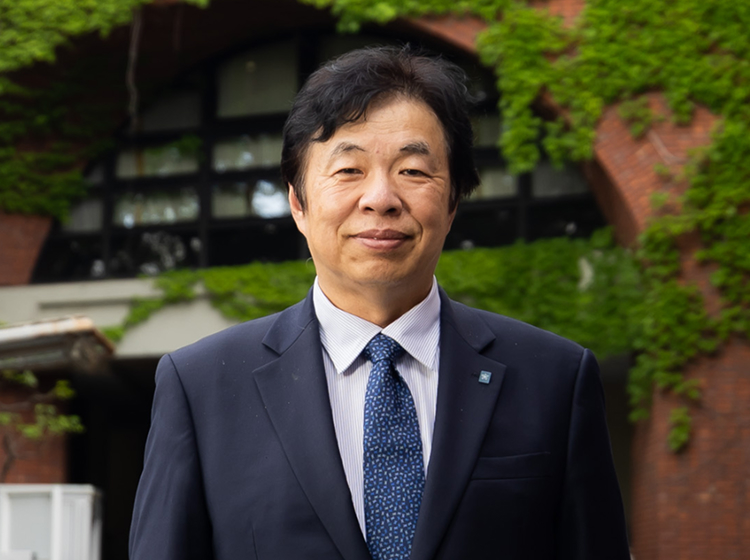
松村 到
MATSUMURA Itaru
学長
President
松村到が近畿大学医学部血液内科の主任教授となったのは2010年のことだ。
第一印象は「元気な大学やなぁ。若い先生たちは素直でやりやすい。ピュアやなぁ」だったという。教授就任後、血液内科の若い医師たちと臨床・研究・教育を楽しむ日々が続き、教授就任の翌2011年、血液内科は「血液・膠原病内科」と名前を変える。新たに迎えた膠原病グループとの仕事も順調であった。その頃、学内においては「臨床実習委員長」を担当し、学生の臨床実習カリキュラムの改善に取り組んでいた。その後、2014年に医学部内に「医師国家試験(国試)対策委員会」が設置され、担当することとなった。その直前に実施された第108回の国試における新卒受験者の合格率が76.2%と全国80大学中で79位まで落ちたからだ。同年の10月から医学部長が楠先生から伊木先生に交代され、同時に教務委員会委員長(教学部長)を担当することとなった。
まず松村は成績下位の学生30人を集めて合宿を行った。興味深いのは、合宿に医師国家試験の予備校の教師を招聘したことだ。
「勉強していないからできない学生もいれば、勉強しているけどできない学生もいる。それぞれに違う対策が必要なんです。ぼくたち、大学の教員は臨床、研究を専門にしていて、国家試験対策の〝プロ〟ではない。プロに任せるのが一番」
この合宿には松村も付き添った。国家試験の対象は基礎医学を基盤とした全診療科であり、さらに社会医学も対象となる。幅広く、偏りのない知識が必要だ。そこで国家試験受験年度の6年生のカリキュラムを見直し、補習を追加した。進級に大きく関係しない国試対策の問題は、松村自身が全科分作成した。
「それまで各科の先生にお願いしていたんです。ところがみなさん、忙しいので、どうしても毎年、同じような問題や補講になってしまう。試験対策として学生が過去問を丸覚えしてしまっていた。国家試験に対応するために自分で問題を作って、各科の先生に内容を確認してもらいました」
試験シーズンは毎週1科目50問の問題を作り、それを解説して、また翌週の次の科の問題を作っていた。1日2、3時間しか寝ていなかったですねと笑う。
その努力もあって、新卒者の国試合格率は、2015年には88.2%と改善し、2016年以降は90%台を維持するようになった。
その頃、今まで自分は、医師としてどれだけ患者さんの寿命を延ばすことができたのだろう、と考えることがあった。「恐らく4000年程度、ヒト1人の寿命を80年とすると、これは50人分の一生になる。しかし、自分一人で延ばせるのは、精一杯頑張っても50-60人分、多くても70人分と考えるようになった。1人の医師ができることは限られているが、医師を100人育てれば、それぞれが患者さんの命を救ってくれる。優秀な医師を送り出すことは大きな社会貢献になる」
松村はこれまで、今の自分に何が求められているのかを考え、行動してきた。近畿大学で自分に求められているのは、臨床医や研究者よりも教育者としての立場なのかもしれないと、教学部長の役職に満足を感じていた。
第一印象は「元気な大学やなぁ。若い先生たちは素直でやりやすい。ピュアやなぁ」だったという。教授就任後、血液内科の若い医師たちと臨床・研究・教育を楽しむ日々が続き、教授就任の翌2011年、血液内科は「血液・膠原病内科」と名前を変える。新たに迎えた膠原病グループとの仕事も順調であった。その頃、学内においては「臨床実習委員長」を担当し、学生の臨床実習カリキュラムの改善に取り組んでいた。その後、2014年に医学部内に「医師国家試験(国試)対策委員会」が設置され、担当することとなった。その直前に実施された第108回の国試における新卒受験者の合格率が76.2%と全国80大学中で79位まで落ちたからだ。同年の10月から医学部長が楠先生から伊木先生に交代され、同時に教務委員会委員長(教学部長)を担当することとなった。
まず松村は成績下位の学生30人を集めて合宿を行った。興味深いのは、合宿に医師国家試験の予備校の教師を招聘したことだ。
「勉強していないからできない学生もいれば、勉強しているけどできない学生もいる。それぞれに違う対策が必要なんです。ぼくたち、大学の教員は臨床、研究を専門にしていて、国家試験対策の〝プロ〟ではない。プロに任せるのが一番」
この合宿には松村も付き添った。国家試験の対象は基礎医学を基盤とした全診療科であり、さらに社会医学も対象となる。幅広く、偏りのない知識が必要だ。そこで国家試験受験年度の6年生のカリキュラムを見直し、補習を追加した。進級に大きく関係しない国試対策の問題は、松村自身が全科分作成した。
「それまで各科の先生にお願いしていたんです。ところがみなさん、忙しいので、どうしても毎年、同じような問題や補講になってしまう。試験対策として学生が過去問を丸覚えしてしまっていた。国家試験に対応するために自分で問題を作って、各科の先生に内容を確認してもらいました」
試験シーズンは毎週1科目50問の問題を作り、それを解説して、また翌週の次の科の問題を作っていた。1日2、3時間しか寝ていなかったですねと笑う。
その努力もあって、新卒者の国試合格率は、2015年には88.2%と改善し、2016年以降は90%台を維持するようになった。
その頃、今まで自分は、医師としてどれだけ患者さんの寿命を延ばすことができたのだろう、と考えることがあった。「恐らく4000年程度、ヒト1人の寿命を80年とすると、これは50人分の一生になる。しかし、自分一人で延ばせるのは、精一杯頑張っても50-60人分、多くても70人分と考えるようになった。1人の医師ができることは限られているが、医師を100人育てれば、それぞれが患者さんの命を救ってくれる。優秀な医師を送り出すことは大きな社会貢献になる」
松村はこれまで、今の自分に何が求められているのかを考え、行動してきた。近畿大学で自分に求められているのは、臨床医や研究者よりも教育者としての立場なのかもしれないと、教学部長の役職に満足を感じていた。
The president, a realist, who is convinced that producing excellent doctors will be a great contribution to society.
In 2010, MATSUMURA Itaru was appointed Chair Professor of Hematology at Kindai University Faculty of Medicine.His first impression was simple and heartfelt: “What an energetic university. The young doctors here are obedient, easy to work with, truly pure.”
From that day on, he enjoyed his new post, working side by side with the younger physicians of the hematology department in clinical practice, research, and education. The following year, in 2011, the department was renamed the Department of Hematology and Connective Tissue Diseases. Collaboration with the newly established connective tissue disease group also progressed smoothly. Around the same time, within the faculty, MATSUMURA also took on the role of Chair of the Clinical Training Committee, where he worked to improve the clinical training curriculum for medical students.
In 2014, the Faculty of Medicine established the “National Medical Examination Preparation Committee,” and MATSUMURA was assigned to oversee it. This was prompted by the fact that, in the immediately preceding 108th National Medical Examination, the pass rate among new graduates had fallen to 76.2%, ranking 79th out of 80 medical schools nationwide. That October, the position of Dean of the Faculty of Medicine was transferred from Professor KUSUNOKI to Professor IKI, and MATSUMURA also assumed the role of chair of the Academic Affairs Committee (Director of Academic Affairs).
The first thing he did was gather the thirty lowest-performing students and organize a training camp. What was remarkable was his decision to bring in instructors from a professional medical licensing examination preparatory school.
“There are students who fail because they don’t study, and there are students who study but still can’t grasp it. Each requires a different strategy,” MATSUMURA explained. “We, as university faculty, specialize in clinical practice and research—we are not professionals at licensing exam preparation. So, it is best to entrust the job to experts.”
MATSUMURA himself accompanied the students at the camp. After all, the National Medical Examination covers all clinical disciplines based on basic medical sciences, as well as social medicine. It demands broad, unbiased knowledge. To strengthen preparation, MATSUMURA revised the curriculum for sixth-year students preparing to sit the exam and added supplementary lessons. For topics less directly tied to advancement but critical for the exam, MATSUMURA personally created practice questions covering every specialty.
“Up until then, I had been asking the professors of each department to create practice questions. However, since everyone was so busy, the same kinds of questions and supplementary lectures tended to be repeated every year. As a result, students preparing for the exam simply memorized past exam questions by rote. To address this, I began writing the questions myself and then had the content checked by the respective faculty members.”
During exam season, MATSUMURA created a set of 50 questions for a single subject every week, provided explanations for them, and then prepared the next subject’s questions for the following week. “I was only sleeping two or three hours a day,” he recalls with a wry smile.
His relentless efforts paid off. By 2015, the pass rate for new graduates had improved to 88.2%, and since 2016 it has consistently remained in the 90% range.
Around this time, MATSUMURA often found himself reflecting: How many years of life had I actually been able to extend for my patients as a physician? By his own calculation, perhaps around 4,000 years in total—roughly the lifespan of fifty individuals, assuming each lived eighty years. “Even if I gave my very best, the number would be fifty or sixty, maybe seventy lives at most. The work of a single doctor has its limits. But if I train a hundred doctors, each of them will go on to save patients. Sending capable physicians out into the world is a tremendous contribution to society.”
MATSUMURA had always sought to understand what was expected of him at each stage of his career and to act accordingly. At Kindai, he came to feel that his role was less as a clinician or researcher and more as an educator, and he found real fulfillment in serving as Director of Academic Affairs.
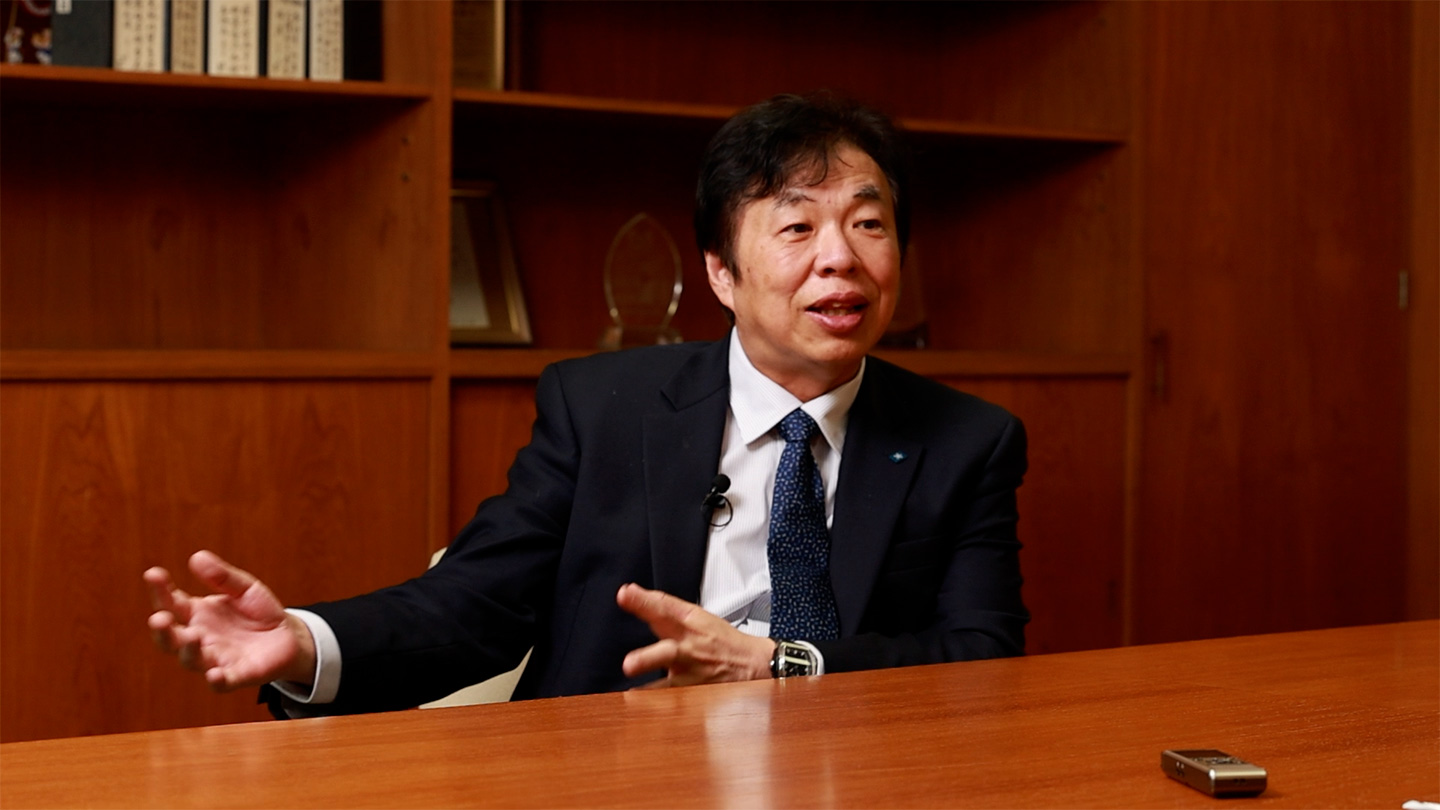
松村は1958年に大阪府松原市で生まれた。非常におとなしくてかわいい子どもだったとは、彼の言葉だ。高校生になり、将来の進路として弁護士か医師を考えるようになった。理系科目を得意としていたため、大阪大学医学部に進んだ。専門として血液内科を選んだのは、「目の前で命が危機にある人を助けたい」と考えたからだ。
血液内科では血液、造血器に関わる疾患の診断、治療を行う。造血器とは、骨髄、リンパ節、脾臓だ。一番の疾患は血液の「がん」である。
「日常診療で扱うのは、白血病、悪性リンパ腫、多発性骨髄腫。9割がた悪性腫瘍。造血器以外のがんは、外科手術、放射線などの治療がある。血液のがんは内科(の薬物)治療で完結する。そこにやり甲斐を感じた」
血液がんの特徴は、血液を通じて全身にがん細胞が広がること。そして固形がんと比較して抗がん剤などの薬物療法が進んでいた。さらに造血幹細胞移植——骨髄移植という選択肢も現れていた。
造血幹細胞とは骨髄の中で血液を作り出す源となる細胞である。がん細胞を消し去るために大量の抗がん剤投与や放射線治療を行うと、この造血幹細胞もダメージを避けられない。造血幹細胞移植とは、治療後、あらかじめ自分の身体から採取しておいた造血幹細胞を戻す、あるいは適合したドナー(提供者)の造血幹細胞を移植して造血を回復させる治療法だ。
この治療は1980年代からわが国でも積極的に実施されるようになり、移植に対応するため、1991年には骨髄バンクが設立されていた。
松村は大阪大学医学部を卒業、85年から市立伊丹病院に勤務し、臨床の現場に立っている。
「18歳の高校生の急性リンパ性白血病の患者さんを担当していました。まずは抗がん剤で治療してから、兵庫医科大学で(骨髄)移植をしてもらいました。ずっと後になってその患者さんが来て、〝先生のおかげで命を救われました〟と言ってくださった」本当に嬉しかったですね、と顔をほころばす。
その後、88年に大阪大学医学部第二内科学教室、そして90年からは大阪大学医学部バイオメディカル教育研究センターで研究することとなった。大学病院の内科医にとって、臨床と研究は両輪である。研究現場を経験することが大切だと考えたのだ。印象に残っているのは、基礎研究医たちの研究に取り組む姿だ。
「ぼくたち臨床医は研究するとき、どうしても論文を書いてキャリアを上げたいと思ってしまいます。しかし、私の恩師である平野(俊夫)先生たちは自然科学の真理を解明したいという純粋な思いが非常に強かった」
その後、松村は97年に大阪大学医学部血液・腫瘍内科に臨床医として戻る。
2010年に近畿大学医学部の教授選に応募したのは、臨床に強い大学で自分の力を試してみたいという思いだったのだ。
血液内科では血液、造血器に関わる疾患の診断、治療を行う。造血器とは、骨髄、リンパ節、脾臓だ。一番の疾患は血液の「がん」である。
「日常診療で扱うのは、白血病、悪性リンパ腫、多発性骨髄腫。9割がた悪性腫瘍。造血器以外のがんは、外科手術、放射線などの治療がある。血液のがんは内科(の薬物)治療で完結する。そこにやり甲斐を感じた」
血液がんの特徴は、血液を通じて全身にがん細胞が広がること。そして固形がんと比較して抗がん剤などの薬物療法が進んでいた。さらに造血幹細胞移植——骨髄移植という選択肢も現れていた。
造血幹細胞とは骨髄の中で血液を作り出す源となる細胞である。がん細胞を消し去るために大量の抗がん剤投与や放射線治療を行うと、この造血幹細胞もダメージを避けられない。造血幹細胞移植とは、治療後、あらかじめ自分の身体から採取しておいた造血幹細胞を戻す、あるいは適合したドナー(提供者)の造血幹細胞を移植して造血を回復させる治療法だ。
この治療は1980年代からわが国でも積極的に実施されるようになり、移植に対応するため、1991年には骨髄バンクが設立されていた。
松村は大阪大学医学部を卒業、85年から市立伊丹病院に勤務し、臨床の現場に立っている。
「18歳の高校生の急性リンパ性白血病の患者さんを担当していました。まずは抗がん剤で治療してから、兵庫医科大学で(骨髄)移植をしてもらいました。ずっと後になってその患者さんが来て、〝先生のおかげで命を救われました〟と言ってくださった」本当に嬉しかったですね、と顔をほころばす。
その後、88年に大阪大学医学部第二内科学教室、そして90年からは大阪大学医学部バイオメディカル教育研究センターで研究することとなった。大学病院の内科医にとって、臨床と研究は両輪である。研究現場を経験することが大切だと考えたのだ。印象に残っているのは、基礎研究医たちの研究に取り組む姿だ。
「ぼくたち臨床医は研究するとき、どうしても論文を書いてキャリアを上げたいと思ってしまいます。しかし、私の恩師である平野(俊夫)先生たちは自然科学の真理を解明したいという純粋な思いが非常に強かった」
その後、松村は97年に大阪大学医学部血液・腫瘍内科に臨床医として戻る。
2010年に近畿大学医学部の教授選に応募したのは、臨床に強い大学で自分の力を試してみたいという思いだったのだ。
Clinical practice and research are the two wheels” — Deeply impressed by basic medical researchers.
MATSUMURA was born in 1958 in Matsubara City, Osaka Prefecture. By his own account, he was a very quiet and gentle child. By the time he reached high school, he was considering a career either as a lawyer or as a physician. Excelling in the sciences, he chose medicine, entering Osaka University’s Faculty of Medicine.He chose hematology as his specialty for the simple reason: “I wanted to save people whose lives were in immediate danger before my eyes.”
In hematology, physicians diagnose and treat diseases related to the blood and hematopoietic organs—the bone marrow, lymph nodes, and spleen. Among these, the most serious are the various forms of blood cancer.
“In daily practice, we deal with leukemia, malignant lymphoma, multiple myeloma. About ninety percent of the cases are malignant tumors. For cancers outside the hematopoietic system, there are treatment options such as surgery or radiation. But blood cancers are managed entirely through internal medicine, with drug therapies alone. That’s where I felt the greatest sense of purpose.”
Blood cancers have their own defining characteristics. Because they spread through the bloodstream, cancer cells can circulate throughout the entire body. Compared with solid tumors, advances in drug therapy—particularly chemotherapy—had been more pronounced. And at that time, a new option was emerging: hematopoietic stem cell transplantation—commonly known as bone marrow transplantation.
Hematopoietic stem cells are the source of blood production within the bone marrow. When a patient undergoes high-dose chemotherapy or radiation therapy aimed at eradicating cancer cells, these stem cells inevitably sustain damage as well. Hematopoietic stem cell transplantation was devised to overcome this: after treatment, the patient’s own previously harvested stem cells are returned, or compatible donor cells are transplanted, to restore the body’s ability to generate blood.
This treatment began to be actively implemented in Japan from the 1980s onward, and the Bone Marrow Bank was established in 1991 to support transplantation.
After graduating from Osaka University’s Faculty of Medicine, MATSUMURA began his clinical career in 1985 at Itami Municipal Hospital, standing on the frontlines of clinical medicine.
“One of my patients was an 18-year-old high school student with acute lymphoblastic leukemia. We began with chemotherapy and then arranged for a bone marrow transplant at Hyogo College of Medicine. Many years later , that patient came back to see me and said, ‘Thanks to you, my life was saved.’ That made me truly happy,” he recalls with a smile.
In 1988, MATSUMURA joined the Second Department of Internal Medicine at Osaka University’s Faculty of Medicine, and from 1990 he continued his research at the university’s Biomedical Research and Education Center. For an internist in a university hospital, clinical practice and research go hand in hand. He believed it was essential to gain firsthand experience in the research field. What left the deepest impression on him was witnessing the dedication of basic science researchers as they immersed themselves in their work.
“As clinicians, when we do research, we tend to think about writing papers and advancing our careers. But my mentor, Professor HIRANO Toshio, and others had an incredibly strong, pure desire to uncover the truths of natural science.”
In 1997, MATSUMURA returned to the Department of Hematology and Oncology at Osaka University’s Faculty of Medicine as a practicing clinician. Then, in 2010, he applied for a professorship at Kindai University Faculty of Medicine, driven by a desire to test his abilities at a university with a strong clinical focus.
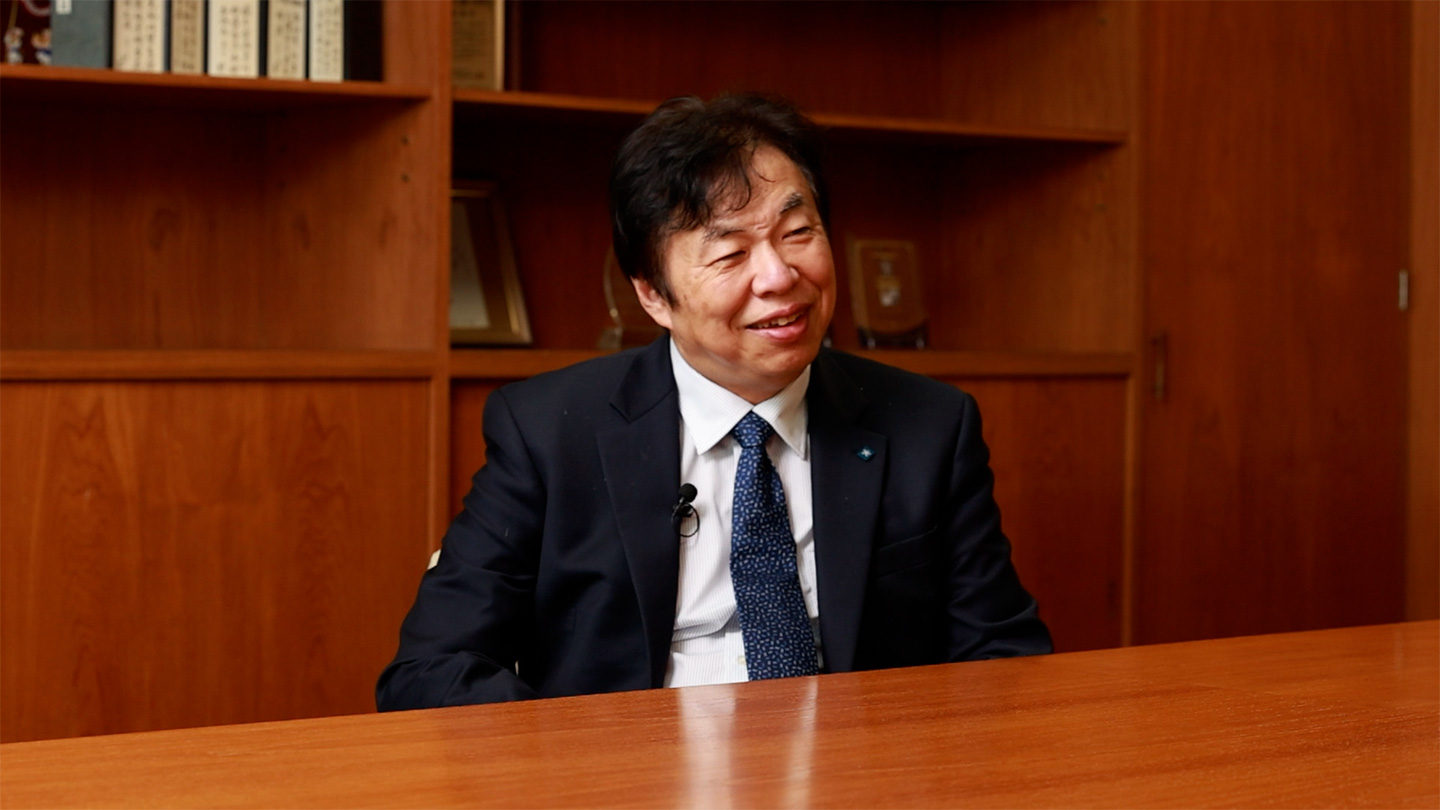
近畿大学で学生と向き合う中で、松村は医師の資質とは何かを自問するようになった。
「1990年台より前の医師たちは、自分たちの経験を非常に大切にしていました。大げさに言えば、白血病の大家と言われる医師が、〝この人にはこの治療がいい〟と言えば、それが正解とされていた。90年代から〝エビデンス・ベースド・メディスン(EBM)〟という考えが出てきた」」
医師が患者を保護、支配するというパターナリズム(父親的温情主義)からEBMへの流れである。
EBMの要素は3つ。1つ目は臨床研究による根拠(エビデンス)があること。2つ目は患者の価値観を重視すること。3つ目は医療従事者の経験や専門性である——高い効果があると見込める治療方法があっても患者の価値観に合わない場合は強行しない。エビデンスのある治療法と患者の価値観を合わせた治療方法を考えるというものだ。
EBMでは、ある医師がその病気の患者さんを100人診た経験があっても、1万人規模のデータがあれば、そちらの方が信頼性が高いことになる。
しかし、である。
「エビデンスとして〝この疾患にはこの薬が推奨されます〟とガイドラインに書かれていれば、医師は患者さんのことを考えず、患者さんに自動的に治療法を当てはめるきらいがあった。そんな中、2020年ぐらいから、シェアード・デシジョン・メイキング(SDM)という概念が広がったのです」
SDMとは、医師と患者がエビデンスのほか、患者さんの価値観、生活信条など個人的、社会的な情報を理解した上で、患者と共に決定を行うプロセスのことで、EBMの基盤となるものだ。共同意思決定という日本語訳があてられる。
これに合致するように、「医学教育において、“患者を総合的に理解する”という教育目標が最近になって加えられました。その根っこにあるのは、患者さんを思いやる気持ちなんです。」
人を育てることに心を砕いた松村が、2018年に医学部学部長となったのは必然だったろう。学部長となった松村が手をつけたのは、教授の選考方法だった。
「学部長の仕事とは研究、教育、診療の全てをレベルアップすることです。病院長と連携しながら、臨床・研究レベルを上げるための核となる優秀な教授を選ぶのが学部長の最も重要な役割」
前学部長時代に、教授選考において教授会での選挙という方法は廃止されていた。選挙を行わない限り、客観性と透明性の担保が必須、誰が考えても当然といわれる教授を選ぶ必要があると松村は考えた。そのために、公募だけでなく、候補となりそうな先生を全国からリストアップし、こちらから応募依頼のレターを送ることとした。また、該当する領域の国内トップの外部教授5人程度にアドバーサリーメンバーとして、候補者の推薦をお願いするとともに、応募者などの評価もお願いした。
「選考委員会におけるこれらの評価時には、従来行われてきたインパクト・ファクターだけでなく、論文被引用回数、FWCI、h5-index、国際共著論文数、トップ10%論文数などの指標がグラフ上で可視化されています。試験対策で予備校講師を招聘した、リアリストの松村らしい発想だ。そのうちに本当に優秀な人が最初から応募してくださるようになって、医学部長時代に23人の主任教授と2人の講座担当教授を選考した。
松村は近畿大学医学部の魅力をこう説明する。「まず自由なこと。そして臨床力が強い。がんの分野だと新薬の治験数は全国3位。研究でも今の医学部長である西尾(和人)先生はゲノム医療のプロフェッショナルです。研究もやろうと思えば存分にできる」
2022年に副学長、そして2024年4月に近畿大学学長に就任した。「学長になりたいという気持ちは全くなかったんです」と冗談めかして笑う。
「就任してみてこれは面白い仕事だなと思いました。それまでは医療、病院という限られた世界しか見てこなかった。学長になると出会う人も変わり、世界が広がりました」
そしてやはりリアリストである。
「東京大学、あるいは京都大学、大阪大学のように全ての学部、分野で世界トップを目指すのは近畿大学には現実的ではない。しかし、水産研究所の養殖や臨床医学の研究が世界トップレベルであるように、特定の分野では十分、世界で戦える」
目指すのは、得意分野で研究力を伸ばし、近畿大学のブランドを高めることだと結んだ。
「1990年台より前の医師たちは、自分たちの経験を非常に大切にしていました。大げさに言えば、白血病の大家と言われる医師が、〝この人にはこの治療がいい〟と言えば、それが正解とされていた。90年代から〝エビデンス・ベースド・メディスン(EBM)〟という考えが出てきた」」
医師が患者を保護、支配するというパターナリズム(父親的温情主義)からEBMへの流れである。
EBMの要素は3つ。1つ目は臨床研究による根拠(エビデンス)があること。2つ目は患者の価値観を重視すること。3つ目は医療従事者の経験や専門性である——高い効果があると見込める治療方法があっても患者の価値観に合わない場合は強行しない。エビデンスのある治療法と患者の価値観を合わせた治療方法を考えるというものだ。
EBMでは、ある医師がその病気の患者さんを100人診た経験があっても、1万人規模のデータがあれば、そちらの方が信頼性が高いことになる。
しかし、である。
「エビデンスとして〝この疾患にはこの薬が推奨されます〟とガイドラインに書かれていれば、医師は患者さんのことを考えず、患者さんに自動的に治療法を当てはめるきらいがあった。そんな中、2020年ぐらいから、シェアード・デシジョン・メイキング(SDM)という概念が広がったのです」
SDMとは、医師と患者がエビデンスのほか、患者さんの価値観、生活信条など個人的、社会的な情報を理解した上で、患者と共に決定を行うプロセスのことで、EBMの基盤となるものだ。共同意思決定という日本語訳があてられる。
これに合致するように、「医学教育において、“患者を総合的に理解する”という教育目標が最近になって加えられました。その根っこにあるのは、患者さんを思いやる気持ちなんです。」
人を育てることに心を砕いた松村が、2018年に医学部学部長となったのは必然だったろう。学部長となった松村が手をつけたのは、教授の選考方法だった。
「学部長の仕事とは研究、教育、診療の全てをレベルアップすることです。病院長と連携しながら、臨床・研究レベルを上げるための核となる優秀な教授を選ぶのが学部長の最も重要な役割」
前学部長時代に、教授選考において教授会での選挙という方法は廃止されていた。選挙を行わない限り、客観性と透明性の担保が必須、誰が考えても当然といわれる教授を選ぶ必要があると松村は考えた。そのために、公募だけでなく、候補となりそうな先生を全国からリストアップし、こちらから応募依頼のレターを送ることとした。また、該当する領域の国内トップの外部教授5人程度にアドバーサリーメンバーとして、候補者の推薦をお願いするとともに、応募者などの評価もお願いした。
「選考委員会におけるこれらの評価時には、従来行われてきたインパクト・ファクターだけでなく、論文被引用回数、FWCI、h5-index、国際共著論文数、トップ10%論文数などの指標がグラフ上で可視化されています。試験対策で予備校講師を招聘した、リアリストの松村らしい発想だ。そのうちに本当に優秀な人が最初から応募してくださるようになって、医学部長時代に23人の主任教授と2人の講座担当教授を選考した。
松村は近畿大学医学部の魅力をこう説明する。「まず自由なこと。そして臨床力が強い。がんの分野だと新薬の治験数は全国3位。研究でも今の医学部長である西尾(和人)先生はゲノム医療のプロフェッショナルです。研究もやろうと思えば存分にできる」
2022年に副学長、そして2024年4月に近畿大学学長に就任した。「学長になりたいという気持ちは全くなかったんです」と冗談めかして笑う。
「就任してみてこれは面白い仕事だなと思いました。それまでは医療、病院という限られた世界しか見てこなかった。学長になると出会う人も変わり、世界が広がりました」
そしてやはりリアリストである。
「東京大学、あるいは京都大学、大阪大学のように全ての学部、分野で世界トップを目指すのは近畿大学には現実的ではない。しかし、水産研究所の養殖や臨床医学の研究が世界トップレベルであるように、特定の分野では十分、世界で戦える」
目指すのは、得意分野で研究力を伸ばし、近畿大学のブランドを高めることだと結んだ。
Kindai University chooses its fields and competes on the global stage.
When MATSUMURA Itaru faced his students at Kindai University, he began to ask himself: what truly defines the qualities of a physician?"Before the 1990s, doctors placed immense value on their own clinical experience. To exaggerate a little, if a doctor known as an authority on leukemia said, ‘This treatment is best for this patient,’ then that was accepted as the correct answer. But from the 1990s onward, the concept of Evidence-Based Medicine (EBM) began to take hold.”
This represented a shift from medical paternalism—where physicians made decisions to protect and control patients— to an approach rooted in EBM.
EBM rests on three pillars: first, evidence derived from clinical research; second, respect for the patient’s own values; and third, the physician’s professional expertise and experience. Even if a treatment is expected to be highly effective, if it does not align with the patient’s values, it should not be imposed. Instead, treatments should be chosen that balance evidence-based recommendations with the patient’s own values.
In this framework, even if one doctor has personally treated 100 patients with a disease, a dataset of ten thousand cases will be seen as more reliable than the doctor’s personal experience.
But here lies a problem.
"If the guidelines state, ‘This drug is recommended for this disease,’ some doctors may apply that treatment automatically, without truly considering the patient in front of them. Around 2020, however, the concept of Shared Decision-Making (SDM) began to spread in response.”
SDM is the process by which doctors and patients together make medical decisions, considering not only evidence, but also the patient’s values, lifestyle, and personal and social circumstances. It is now regarded as a foundation of EBM. In Japanese, it has been translated as “joint decision-making.”
"In line with this, medical education has recently added the goal of teaching students to ‘understand the patient in a holistic way.’ At its root is a simple but profound truth: the spirit of compassion for the patient.”
For MATSUMURA Itaru, who had devoted himself to cultivating others, becoming Dean of Kindai University Faculty of Medicine in 2018 felt almost inevitable. One of the first reforms he undertook in his new position concerned the method of selecting professors.
"The job of the Dean of the Faculty of Medicine is to raise the level of research, education, and clinical practice across the board. In collaboration with the hospital director, the dean’s most important role is to identify and appoint outstanding professors who can serve as the nucleus for elevating clinical and research standards.”
Under the previous dean, the old system of electing professors through faculty vote had already been abolished. But if there were to be no elections, MATSUMURA believed that objectivity and transparency had to be guaranteed. Professors needed to be chosen in a way that anyone could recognize as fair and beyond question.
To achieve this, he instituted a new approach: not only would positions be publicly advertised, but potential candidates from across the country would be identified and personally invited to apply through formal letters. In addition, for each relevant field, around five leading professors from outside the university were appointed as advisory members, tasked with recommending suitable candidates and evaluating the applicants themselves.
"During the evaluation process in the selection committee," MATSUMURA explained, "we no longer rely solely on the traditional impact factor. Instead, we visualize data such as citation counts, FWCI, h5-index, number of international coauthored papers, and number of top 10% cited papers—all laid out in graphs for clarity.”
It was a characteristically pragmatic idea, similar to the way he had once hired prep school lecturers for exam preparation. In time, this approach began attracting truly outstanding candidates from the outset, and during his deanship, Matsumura selected 23 full professors and two course directors.
Matsumura says the appeal of Kinki University’s Faculty of Medicine lies in its openness and strong clinical capabilities. “In oncology, for example, we rank third nationwide in the number of clinical trials for new drugs. And in research, our current dean, Dr. NISHIO Kazuto, is a leading authority in genomic medicine. For those who want to pursue research, there’s no shortage of opportunities.”
In 2022, MATSUMURA was appointed Vice President of Kindai University, and in April 2024, he assumed the presidency. “I never had any desire to become president,” he said with a wry smile. “But once I took on the role, I realized it was a fascinating job. Until then, my world had been limited to medicine and hospitals. As president, the people I meet have changed, and my world has expanded.”
Ever the realist, he is candid about the university’s ambitions. “It’s not realistic for Kindai to aim for world-class status across every faculty and discipline, like the University of Tokyo, Kyoto University, or Osaka University. But in certain fields, we can absolutely compete on the global stage—for example, our aquaculture research at the Fisheries Laboratory, or clinical medical research.”
In the end, MATSUMURA concluded that the path forward is clear: to strengthen research in areas where the university already excels, and through that, to elevate the brand of Kindai University itself.
